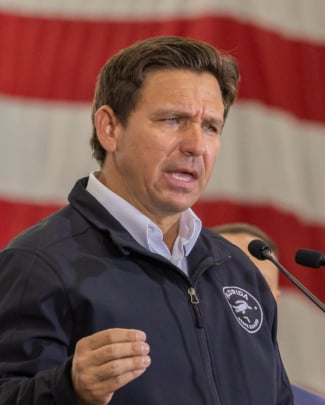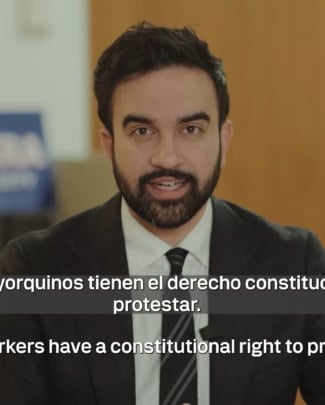Call to prayer wails five times a day in first Muslim majority-ruled community in America
Call to prayer wails five times a day in first Muslim majority-ruled community in America
No, its not church bells ringing, but a Muslim call to prayer over the loudspeakers in the town of Hamtramck, Michigan. With the most recent election, a majority of the city council elected were Muslims. How has this influx of Islamic followers in the small town on Hamtramck affected the American way of life? If it weren’t for the McDonalds and a few other recognizable stores, you may think you were transported to the Middle East. Women in niqabs walk the streets shopping, only their eyes visible. Stores with Arabic writing in the windows. And the startling call to prayer five times a day, over the loudspeakers of the mosques. Is this the new reality for communities in America as we import more and more Middle Easterners into our nation, and there is little assimilation?
From The Washington Post:
HAMTRAMCK, MICH. — Karen Majewski was in such high demand in her vintage shop on a recent Saturday afternoon that a store employee threw up her hands when yet another visitor came in to chat. Everyone wanted to talk to the mayor about the big political news.
Earlier this month, the blue-collar city that has been home to Polish Catholic immigrants and their descendants for more than a century became what demographers think is the first jurisdiction in the nation to elect a
majority-Muslim council.

A Muslim woman wears a niqab as she walks past a McDonald’s restaurant in Hamtramck, Mich. (Salwan Georges/For The Washington Post)
It’s the second tipping for Hamtramck (pronounced Ham-tram-ik), which in 2013 earned the distinction of becoming what appears to be the first majority-Muslim city in the United States following the arrival of thousands of immigrants from Yemen, Bangladesh and Bosnia over a decade.
“It’s traumatic for them,” said Majewski, a dignified-looking woman in a brown velvet dress, her long, silvery hair wound in a loose bun.
Around her at the Tekla Vintage store, mannequins showcased dresses, hats and jewelry from the mid-20th century, and customers fingered handbags and gawked at the antique dolls that line the store, which sits across the street from Srodek’s Quality Sausage and the Polish Art Center on Joseph Campau Avenue, the town’s main drag.
Majewski, whose family emigrated from Poland in the early 20th century, admitted to a few concerns of her own. Business owners within 500 feet of one of Hamtramck’s four mosques can’t obtain a liquor license, she complained, a notable development in a place that flouted Prohibition-era laws by openly operating bars. The restrictions could thwart efforts to create an entertainment hub downtown, said the pro-commerce mayor.
And while Majewski advocated to allow mosques to issue calls to prayer, she understands why some longtime residents are struggling to adjust to the sound that echos through the city’s streets five times each day.
“There’s definitely a strong feeling that Muslims are the other,” she said. “It’s about culture, what kind of place Hamtramck will become. There’s definitely a fear, and to some degree, I share it.”
Saad Almasmari, a 28-year-old from Yemen who became the fourth Muslim elected to the six-member city council this month, doesn’t understand that fear.
Almasmari, the owner of an ice cream company who campaigned on building Hamtramck’s struggling economy and improving the public schools, said he is frustrated that so many residents expect the council’s Muslim members to be biased. He spent months campaigning everywhere in town, knocking on the doors of mosques and churches alike, he said.
“I don’t know why people keep putting religion into politics,” said Almasmari, who received the highest percentage of votes
(22 percent) of any candidate. “When we asked for votes, we didn’t ask what their religion was.”
Surrounded by Detroit, Hamtramck is Michigan’s most densely populated city, with about 22,000 residents occupying row after row of two-story,
turn-of-the-century bungalows packed into two square miles. Polish Catholic immigrants began flocking to Hamtramck, which was originally settled by German farmers, in 1914 when the Dodge brothers opened an auto assembly plant in town.
While the city’s Polish Catholic population has shrunk from
90 percent in 1970 to about 11 percent today, in part as the old residents have moved to more prosperous suburbs, Polish American culture still permeates the town.
Labor Day, known as Polish Day here, is marked with music, drinking and street dancing. The roof of the Polish cathedral-style St. Florian Church peaks above the city landscape, and a large statue of Pope John Paul II, who visited the city in 1987, towers over Pope Park on Joseph Campau Avenue. The Polish pope’s cousin, John Wojtylo, was a Hamtramck city councilman in the 1940s and 1950s, according to local historian Greg Kowalski.
The once-thriving factory town now struggles with one of the highest poverty rates in Michigan. In 2009, American Axle shut down its plant in Hamtramck, laying off hundreds of workers. There is a new class of entrepreneurs, including Igor Sadikovic, a young Bosnian immigrant who plans to open a coffee shop with an art gallery by next summer, and Rebecca Smith, who owns a handbag store that employs Muslim women.
But the new businesses have not been enough to offset the loss of a manufacturing base and reductions in state revenue sharing. Since 2000, Michigan has twice appointed an emergency manager to the city, which has an annual operating budget of $22 million.
Hamtramck’s exceedingly low home prices and relatively low crime rate have proved especially attractive to new immigrants, whose presence is visible everywhere. Most of the women strolling Joseph Campau Avenue wear hijabs, or headscarves, and niqabs, veils that leave only the area around the eyes open. Many of the markets advertise their wares in Arabic or Bengali, and some display signs telling customers that owners will return shortly — gone to pray, much in the same way Polish businesses once signaled that employees had gone to Mass.
Many longtime residents point to 2004 as the year they suspected that the town’s culture had shifted irrevocably. It was then that the city council gave permission to al-Islah Islamic Center to broadcast its call to prayer from speakers atop its roof.
“The Polish people think we were invading them,” said Masud Khan, one of the mosque’s leaders, recalling that time in an interview earlier this month. “We were a big threat to their religion and culture. Now their days are gone.”
The mosque, which attracts about 500 people for its Friday prayer services, has purchased a neighboring vacant limestone building in the heart of the city that once was a furniture store. The mosque’s leaders plan to put a minaret — a spire — on the building and use it to continue broadcasting a call to prayer five times a day.
The private sale enraged city leaders, including the mayor, who sees the area as key to commercial growth. Mosque leaders estimate that the 20,000-square-foot building will hold up to 2,000 people once the renovation is finished next year.
The town’s transformation caught Mike Bugaj off guard. When the Hamtramck native left to join the Air Force in 1972, the city was widely referred to as “Little Warsaw.” When he returned from the military in 1995, “the Muslims were here,” said Bugaj, who is of Polish and Native American descent.
The new majority Muslim council has Bugaj worried that old traditions, like the Polish festival and Fat Tuesday’s paczki day, soon will be wiped away.

Air Force veteran Mike Bugaj, 61, in front of the Polish Legion of American Veterans Post 10 in Hamtramck. (Salwan Georges/For The Washington Post)

Bugaj holds a political cartoon. The Hamtramck native worries about the loss of Polish traditions in the city. (Salwan Georges/For The Washington Post)
He and other residents are “concerned about what they would want to change, that they could mistreat women,” said Bugaj, who wore feather earrings and a T-shirt with wolves on it. “Don’t come over to America and try to turn people to your way of thinking.”
Wayne Little, who has been a pastor for nearly 40 years at Corinthian Baptist Church, said many of the city’s African American residents are also waiting to see whether the new Muslim-majority city council will represent their interests.
“They are clannish and stick together. . . . The jury is out on them.” Little said.
But Hamtramck’s Muslim population is hardly a monolith — the city is about 23 percent Arabic,
19 percent Bangladeshi and 7 percent Bosnian. The predominantly Muslim groups don’t intermingle much because of language differences, according to Thaddeus Radzilowski of the Piast Institute, a census information center.
Adding to the city’s burgeoning diversity are the young, white hipsters who have begun to migrate here from surrounding areas for the food, bars and art shows.
On a recent Saturday, about
40 people crowded into a one-room studio to sip wine from red Solo cups and enjoy a watercolor exhibition by African American artist Olayami Dabls as reggae music thumped in the background. The nudity and sexuality portrayed in Dabls’s paintings provided a startling contrast that afternoon to the handful of veil-clad Muslim women poring over produce at the Yemeni-owned grocery store visible across the street through the window.
Even some residents who are nervous about the new council speak of the city’s diversity with pride, noting the eclectic mix of restaurants and the fact that at least 27 languages are spoken in Hamtramck schools.
Frank Zacharias, an elderly Polish American usher at St. Ladislaus, the Catholic parish across the street from the mosque, is intimately familiar with life on Hamtramck’s streets, which he tromped for 28 years as a mail carrier before retiring. The changes have stunned him, he said.
“It was hard at the beginning,” he said, referring to 2004, when the mosque began the call to prayer.
But, he added: “They’re human. You gotta live with them. Hamtramck is known for diversity.”
University of Michigan at Dearborn professor Sally Howell, who has written a book on Michigan and U.S. Muslims, said that although some outsiders have equated the election results with “a sharia takeover,” that is not a fear she hears expressed by Hamtramck’s non-Muslims.
It all boils down to “a fear that this city council won’t represent the community,” Howell said. Her own sense, she said, is that it will.
The discord intensified in the weeks before the election, beginning when several senior citizens living in an apartment complex complained about the volume of the 6 a.m. call to prayer from a nearby mosque.
Susan Dunn, who was on her fifth unsuccessful run for city council, raised the issue before the governing body.
“I have my own rights, as well,” she said while baking her son’s birthday cake in her kitchen. “I’m not a hater. It wasn’t a calculated move.”
At one point as she spoke, a mosque close to Dunn’s house began broadcasting the call to prayer. “You try reading a book in your back yard while your dog is barking to that,” Dunn said, clearly exasperated.

City Council member Saad Almasmari, 28, far right, talks with community members inside a grocery store. (Salwan Georges/For The Washington Post)
On the eve of the vote, then-candidate Almasmari sent a photo of a flier he said he had found on the street to Majewski, the mayor, and Dunn. “Let’s get the Muslim out of Hamtramck in November 3rd. Let’s take back our city,” it read. The photo of the flier, which was illustrated with images of three white candidates, including Dunn, began circulating on Facebook. Dunn said she had nothing to do with it.
Then, after the election, a Muslim community organizer upset many residents when he praised the composition of the new council.
“Today, we show the Polish and everybody else,” said Ibrahim Algahim in an address to fellow Muslims that was captured on video.
Muslim community activist Kamal Rahman said he empathizes with the older residents’ concerns and has been working to help unify the town by meeting with city leaders.
Rahman, who in 1986 became one of the first Bengalis to attend a Hamtramck high school, said he considered moving to a mostly white Detroit suburb but decided against it once he discovered that a Ku Klux Klan group also had an address there. Instead, he built a five-bedroom home next to a Yemeni mosque just outside of Hamtramck, and sends his children to charter schools in the city.
Rahman encourages other Muslims to watch their language, because it can seem threatening.
“It sends the wrong message. If I were white, I would feel scared,” he said.
As he sat in a Yemeni restaurant neatly dressed in a blue dress shirt and dark blue striped tie, Almasmari, the council member, recalled feeling shaken in the weeks leading up to the election, when he discovered that dozens of the yard signs touting his candidacy had been spray-painted with an “X.”
On a boarded-up building on the city’s main street, a poster to re-elect council member Anam Miah had been partially covered with big block letters — “DON’T VOTE” — and a swastika was drawn on Miah’s forehead.
But Almasmari insists that longtimers’ fears are unfounded. Already, he said he has scheduled a meeting with residents who wish to talk about their concerns — economic, educational and otherwise.
“People talk about Muslims by talking about ‘them,’ but we’re not going to be as single-minded as people think,” said Almasmari, a married father of three who covered his Facebook profile picture last week with the French flag filter.
Back in her vintage shop down the block, Majewski said she sympathizes with the stories of immigrants in search of a better life. It is a subject the mayor knows something about, having specialized in immigration and ethnicity when she earned her doctorate in American culture at the University of Michigan, said Majewski, who works at UM’s Institute for Research on Labor, Employment and the Economy.
A few minutes later, she pointed to a large, vacant building down the street that she said had once housed a popular department store. It was purchased by a Yemeni immigrant and has sat empty for two years, she said.
“It creates a lot of resentment and drags down the property values. That’s a real source of tension,” Majewski said. “Is that ethnic? . . . What do you call that? Can you criticize his lack of action? There’s certainly an ethnic element, the feeling that they don’t care about the city. How do you disentangle those?”
She paused to tell a shopper that the red plaid shirt he was trying on looked like a good fit before concluding aloud that the new conflicts in Hamtramck have less to do with ethnicity and religion and more about to do with what it means to be a good neighbor.
“We live on top of each other,” she said. “You can pass your plate through the window to the person next door.”
By Sarah Pulliam Bailey, Washington Post
Partner with Us
Intercessors for America is the trusted resource for millions of people across the United States committed to praying for our nation. If you have benefited from IFA's resources and community, please consider joining us as a monthly support partner. As a 501(c)3 organization, it's through your support that all this possible.


We use cookies to ensure that we give you the best experience on our website. If you continue to use this site we will assume that you are happy with it. Privacy Policy




Comments
No comments have been posted yet; you can be the first!